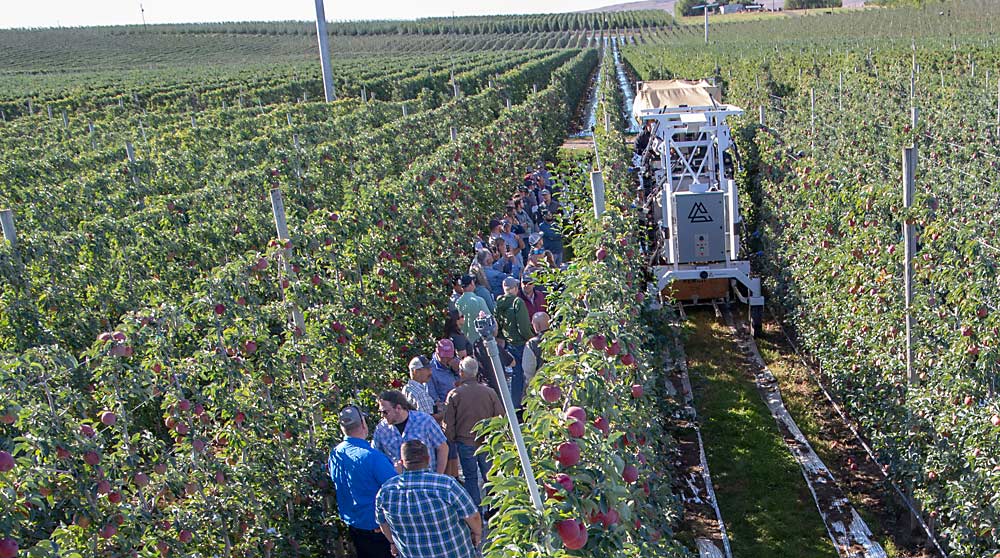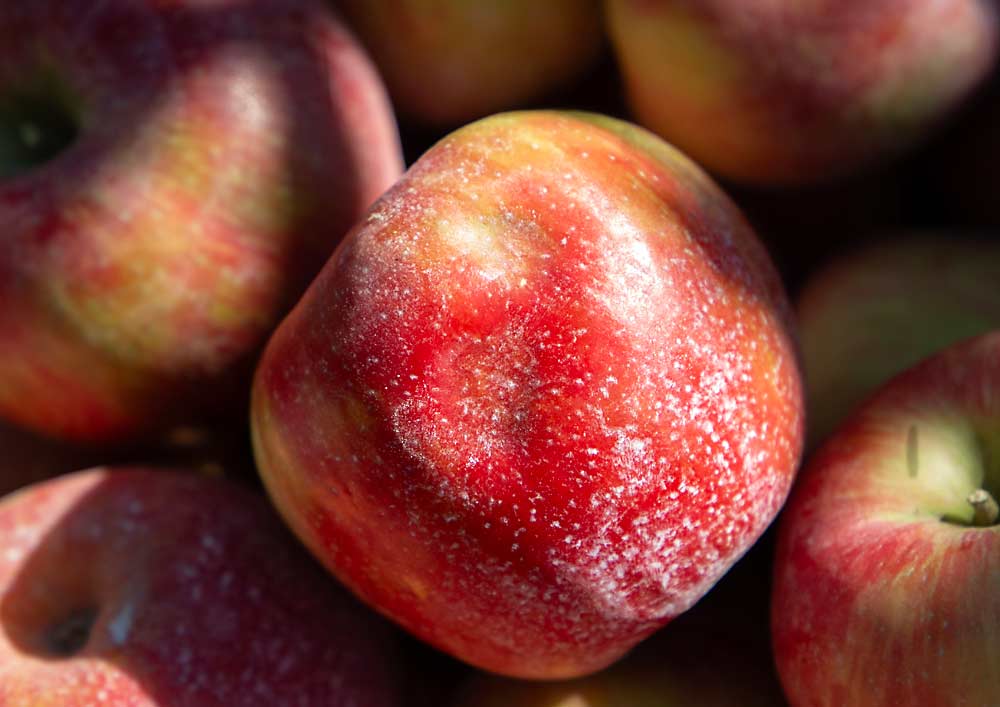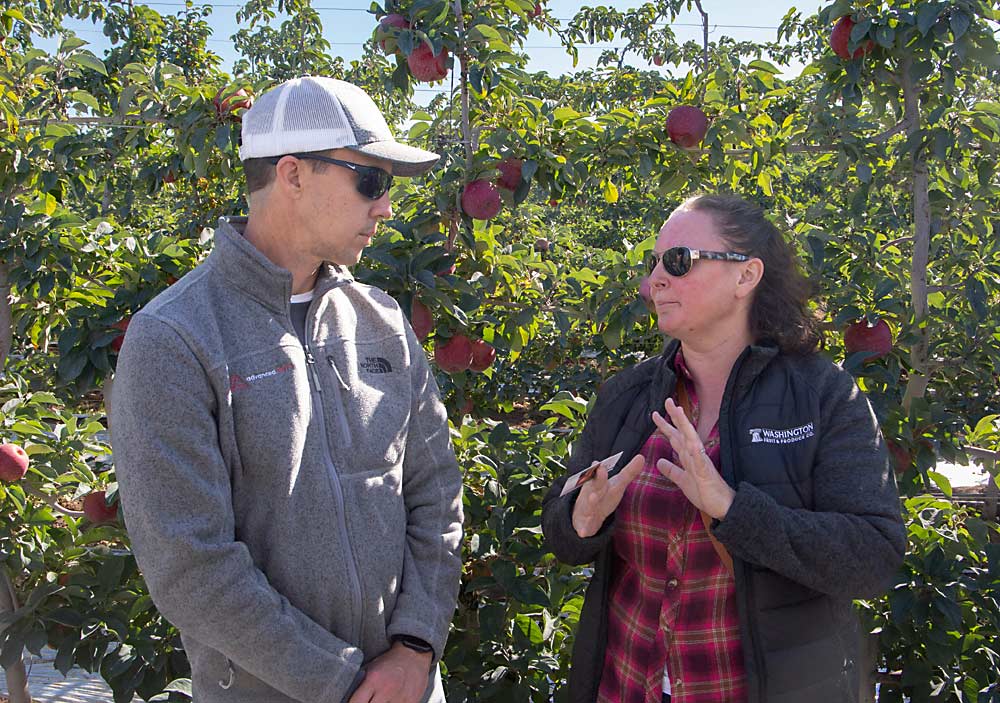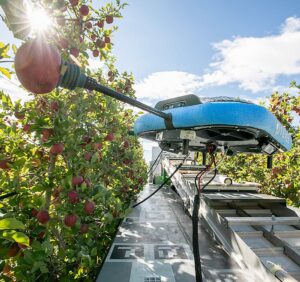—by Ross Courtney

Only one company’s robot is picking apples in Washington this year, but growers are pleased with its progress.
Advanced.farm returned to Washington for its third consecutive year to harvest apples on a trial basis, running two machines with eight orchard companies. The tech company has an ambitious goal of commercial adoption by 2027.
“We have to have a bold vision and have to have bold goals,” said Kyle Cobb, president and co-founder of the Davis, California, company.
Cobb and his colleagues estimate an eventually $300,000 price tag per unit.
The company’s two primary commercial competitors that have run trials in Washington — both Israeli companies — are sticking with activities outside the United States this year.
The advanced.farm robots have six articulated arms, each with suction-cup end effectors guided by computer vision to pluck apples and deposit them on a system of conveyor belts that lead to a bin filler. The machine drives itself, but human operators ride on a platform to sort out culls and clip stems. The company aims to automate those functions over the next 10 years by adding optical sorters and mechanical clippers.
Company engineers spent the winter fine-tuning software algorithms, redesigning conveyor belts, padding surfaces and switching to lighter material in the end effectors. They now claim the machine picks 2,500 apples per hour, about three times the rate of its 2023 trials.
As for picking efficiency, on average across this year’sGala harvest, the robot successfully collected 30 percent of available fruit and damaged 12 percent of apples picked. This year in a Honeycrisp block, pruned for robotic optimization, the machine collected 45 percent, Cobb said.
As the season progressed, the robot’s performance “blew past the targets” for damage, said Ines Hanrahan, executive director of the Washington Tree Fruit Research Commission, which has funded projects related to robot harvesters — including with advanced.farm.
“They have really listened to our input and integrated it rapidly,” she said in October. “Damage rates are now similar to people, if the orchard is trained properly.”

For comparison, the research commission determined that a human picks an average of 1,800 apples per hour without stem clipping, Hanrahan said. That figure was averaged from data on workers using ladders and platforms to pick many different varieties from blocks with different training systems, including those with planar and three-dimensional orientation, she said.
Cobb is confident his team will continue to improve their performace numbers in the next few years before the robot is ready for commercial use.
Advanced.farm also is working with Orchard Robotics, a vision and analytics company that scans orchards ahead of the robot’s pass to paint a clearer picture of fruit availability and harvest parameters, such as color specs.
The developers at advanced.farm founded the company in 2018 for automating strawberry harvest but have since moved solely to apples, Cobb said. The apple industry’s trellises and genetics lend themselves more to mechanization, while higher seasonal labor needs present more growth opportunity, Cobb said.
The company has come this far with $35 million in startup funding over six years from Kubota, CNH Industrial, Yamaha Motor Co., Catapult Ventures and Impact Ventures, Cobb said. It needs another $10 million to place 20 commercial units in orchards by 2027 and another $10 million to scale beyond that, he said.
Improvement
Growers who have watched the machine over the past few years agree it has improved.
Jeff Cleveringa of Columbia Fruit Packers has hosted advanced.farm for multiple years and considers the 2027 commercialization target “within reason,” he said.
Damage rates have dropped below the 12 percent the company is touting, at least on his Galas, said Cleveringa, also a member of the Washington Tree Fruit Research Commission.
“This year, they’ve really fixed it,” he said. “I mean, massive improvement.”
Picking partners wanted
Advanced.farm, a robotic apple harvest startup, is looking for orchardist partners in Washington for the 2025 harvest.
For this stage of development, participants should:
—Have vertical trellises on relatively flat ground with row spacing between 9 feet and 11 feet.
—Be willing to adjust pruning and defoliating techniques to maximize the robot’s success.
—Be willing to track fruit quality with separate packout reports.
—Be willing to operate the machine semi-independently.
Cleveringa believes the machine would pick faster than a human today, but that alone wouldn’t fully justify the cost. The robot needs to outperform a crew of four pickers on a platform working below a certain cost, he said. Last year, that was about 2–3 cents per apple. This year, he puts that closer to 4 cents.
In September, advanced.farm held a demo for about 60 members of the Yakima POM Club at Chiawana Orchards near Cowiche. Company leaders invited feedback and even criticism from growers they hope will buy their machine someday.
“There’s no downside to being honest with our potential partners,” Cobb said.
Julia Bringolf, vice president of Royal Bluff Orchards, described herself as “picky” as she watched the demo and inspected a bin of Honeycrisps picked by the machine.
She said the bin looked clean overall with a few apples bruised by the robot. Other apples had damage and scuffing not caused by the robot, but she wouldn’t send them to the packer.
“Field sorting our culls is one of our top priorities,” she said. “Making sure that nothing bad goes in the bin is really, really important. It’s the only way to really maximize your returns.”
For the price, she would expect at least a 70-percent thoroughness rate with only 5 percent or less damage. Cobb considers those targets doable.

Drew Washut, an engineer for Allan Bros. Fruit, has watched the robot two years now and can see the improvement, mostly in speed.
“It definitely has a lot less wasted movement in each robotic arm,” Washut said. “Last year was a lot of scanning. This year it gets to its own location and definitely goes after the next fruit right away.”
Evan Gibbons, a field representative for Kershaw Fruit and Cold Storage, liked the overall quality in the sample bin. It wasn’t perfect, but he would pack it. He expressed concern about the suction cups removing spurs with the fruit, something human pickers sometimes do, too.
Overall, Bringolf, Washut and Gibbons said they were excited about the company’s progress. Bringolf has discussed hosting trials in her blocks, while Gibbons expects automation to color his career.
“My timeline in ag, I’ve got 35 years to go,” Gibbons said. “So, I know this is going to be something we’re going to be dealing with, and I’m ultimately looking forward to see where it’s going.” •
They’ll be back
Representatives for two orchard robotics companies that previously ran trials in Washington say they are focusing their activities in other countries this year.
However, Israeli companies Tevel and Fresh Fruit Robotics plan to return to the United States someday.
Tevel’s machine involves suction-cup equipped drones tethered to a system of conveyors and a bin filler mounted on an Alpha platform. In 2022 and 2023, the company picked apples in Washington and stone fruit in California.
“We decided to focus our activities this season in Europe and in South America (in the opposite season), where we already have paying customers,” said Ittai Marom, general manager, in an email to Good Fruit Grower. “The alternative — to work simultaneously in the U.S. and in Europe while implementing changes — is more of a defocus for us and doesn’t push the system forward as much. I hope that we’ll be in a better position to come back to Washington next year.”
Fresh Fruit Robotics is raising money and operating in Israel, said Avi Kahani, founder and CEO.
“We are currently in the process of raising additional funding to support our ongoing development and future growth,” Kahani said. “We remain committed to our long-term vision and look forward to resuming our expansion plans in the near future.”
—R. Courtney







Leave A Comment